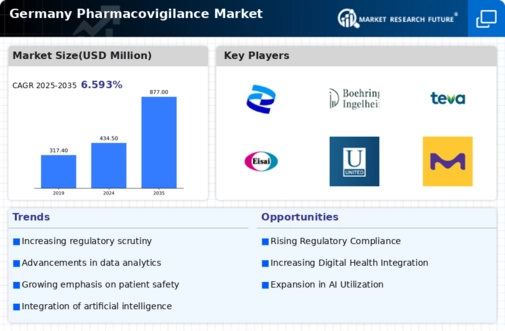Increasing Regulatory Scrutiny
The pharmacovigilance market in Germany is experiencing heightened regulatory scrutiny, which is driving the demand for robust safety monitoring systems. Regulatory bodies, such as the Federal Institute for Drugs and Medical Devices (BfArM), are enforcing stricter guidelines for adverse event reporting and risk management. This regulatory environment compels pharmaceutical companies to invest in comprehensive pharmacovigilance systems to ensure compliance. As a result, the market is projected to grow at a CAGR of approximately 8% over the next five years. Companies that fail to adhere to these regulations may face significant penalties, further emphasizing the need for effective pharmacovigilance practices. The increasing complexity of drug safety regulations necessitates the adoption of advanced technologies and methodologies, thereby propelling the growth of the pharmacovigilance market in Germany.
Rising Demand for Real-World Evidence
The demand for real-world evidence (RWE) is significantly influencing the pharmacovigilance market in Germany. As healthcare stakeholders seek to understand the safety and effectiveness of medications in diverse populations, the integration of RWE into pharmacovigilance practices becomes essential. This trend is driven by the need for more comprehensive data that reflects actual patient experiences. The market for RWE is expected to reach €1 billion by 2026, indicating a substantial opportunity for pharmacovigilance service providers. By leveraging RWE, companies can enhance their safety monitoring processes and provide regulators with more robust data, thereby improving patient outcomes. This shift towards RWE is likely to reshape the landscape of the pharmacovigilance market, as organizations adapt to new methodologies and data sources.
Growing Focus on Patient-Centric Approaches
The pharmacovigilance market in Germany is witnessing a growing emphasis on patient-centric approaches to drug safety. This trend is driven by the recognition that patient feedback is invaluable for identifying adverse drug reactions and improving overall safety profiles. Pharmaceutical companies are increasingly engaging with patients through surveys and social media to gather insights on their experiences with medications. This shift towards a more inclusive approach is expected to enhance the quality of pharmacovigilance data and foster trust between patients and healthcare providers. As a result, organizations that prioritize patient engagement may gain a competitive edge in the market. The focus on patient-centricity is likely to reshape the pharmacovigilance market, leading to more effective safety monitoring and improved patient outcomes.
Technological Integration in Safety Monitoring
The integration of advanced technologies into safety monitoring processes is a key driver of the pharmacovigilance market in Germany. Innovations such as artificial intelligence (AI), machine learning, and big data analytics are transforming how adverse events are detected and analyzed. These technologies enable faster data processing and more accurate risk assessments, which are crucial for timely regulatory reporting. The market for AI in pharmacovigilance is projected to grow by 15% annually, reflecting the increasing reliance on technology to enhance safety monitoring. As pharmaceutical companies adopt these technologies, they can improve their operational efficiency and reduce costs associated with manual data handling. This technological evolution is likely to play a pivotal role in shaping the future of the pharmacovigilance market.
Expansion of Biopharmaceuticals and Biosimilars
The expansion of biopharmaceuticals and biosimilars is significantly impacting the pharmacovigilance market in Germany. As the biopharmaceutical sector continues to grow, the complexity of monitoring these products increases, necessitating enhanced pharmacovigilance practices. The market for biosimilars is projected to reach €3 billion by 2027, indicating a substantial opportunity for pharmacovigilance services tailored to these products. Regulatory agencies are particularly vigilant regarding the safety of biopharmaceuticals, which often require more rigorous monitoring due to their unique characteristics. This trend compels pharmaceutical companies to invest in specialized pharmacovigilance systems that can effectively manage the safety profiles of these complex therapies. Consequently, the growth of biopharmaceuticals and biosimilars is likely to drive innovation and investment in the pharmacovigilance market.
























Leave a Comment